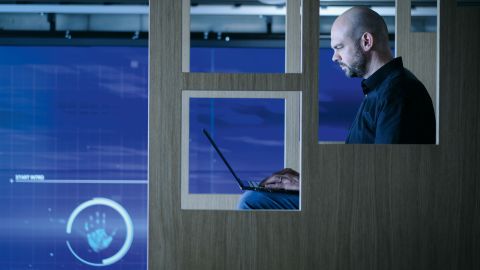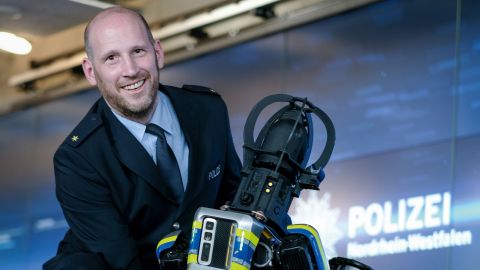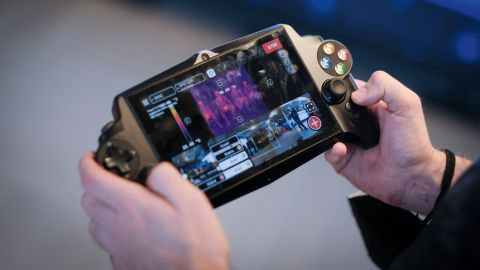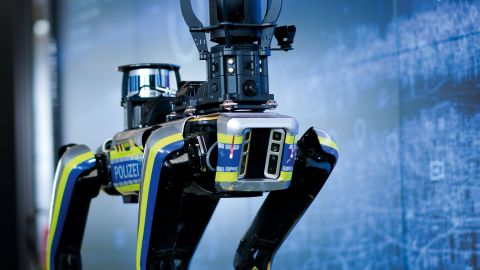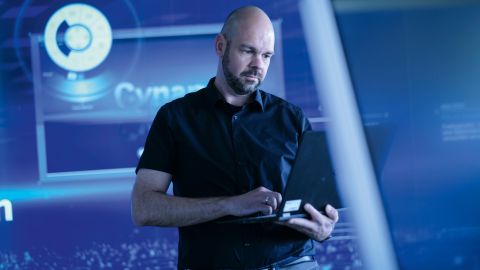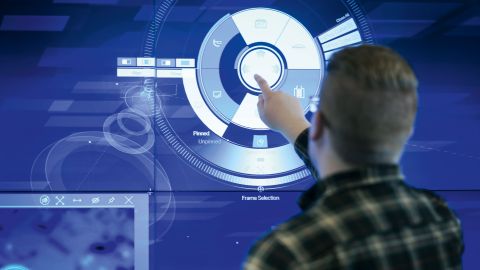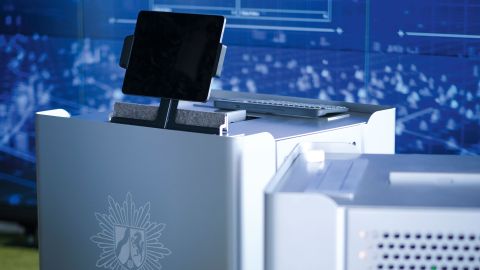This office of clever minds is not one of the usual official offices, but rather resembles a playground from the design studio with movable Bouroullec armchairs in trendy colors on a green carpet. The official research laboratory, which opened at the beginning of the year, operates where other creative minds have settled. Cool start-ups also think and work in the same building. The environment is inspiring and quite exciting.
The state parliament has initially provided 4.3 million euros for the Innovation Lab. Other federal states are looking to Duisburg with interest. The robot dog "Spot" does the rest as an advertising testimonial. A few weeks ago, the four-legged technology colleague had his first assignment and helped to clear up a large fire in a residential complex in Essen.
"We are allowed to experiment and sometimes get off on the wrong track," says Sebastian Naujoks. The job at the Innovation Lab almost seems like winning the lottery to him. The 24-year-old feels he is in good hands where pioneering digital solutions and forms of work are developed. The Landesamt für Zentrale Polizeiliche Dienste (LZPD) is in charge. "I find helping to shape the future of the police and testing advanced technology extremely exciting," explains the new employee. The job advertisement immediately appealed to him.
Sebastian Naujoks prevailed against 20 applicants. The electrical engineer, who has just completed his studies, joined the team on March 1. The government employee is now looking forward to being able to conduct open-ended research, just like in science. The team initially consists of five colleagues - in close cooperation with the LZPD and other police authorities. But also with universities and industry.
"Technology is developing rapidly," says LZPD Director Thomas Roosen. With conventional methods, the police could eventually fall behind. "But we want to get ahead of the situation." That's why it's a great opportunity to think about strategic issues without being distracted from day-to-day business. "We want to provide important impetus with the Innovation Lab. The aim is to find answers to what lies ahead," says the 58-year-old police officer, describing the challenge. Digital concepts are particularly in demand.
The LZPD already offers more than 100 central police-specific IT solutions for all police authorities. Roosen has been focusing on the optimization of information technology for 22 years, mostly at the LZPD and for five years as a consultant at the Ministry of the Interior. The pace of change has now accelerated. "We responded to this by setting up the lab." The head of the LZPD believes that you feel completely different in this environment. "We also want to surprise people with other good ideas - for example, to create a creative working environment."
The lab has been under consideration for around two years. "From the third quarter of 2021, everything suddenly happened very quickly," says computer scientist Markus Erwig. Since February 1, he has been making his expertise fully available to the new facility at Duisburg's Calaisplatz. He is impressed by how quickly legal issues were clarified, the suitable floor was found and the high-quality technical equipment was found.
The 500 square meter space is divided into a total of four zones. "In November, the rooms here were still bare," recalls the 42-year-old. "We were able to move in in January." Erwig is delighted with the breath of fresh air. He doesn't have a permanent office or his own desk. "It's unusual and wonderful," says the Dinslaken native. Everyone is committed to further improving the work of the police. "We are highly motivated."
Visitors from other police authorities, academia and the private sector come almost every day. On the same day that "Streife" is allowed to take a look behind the scenes of the Innovation Lab, experts from the Federal Criminal Police Office, the State Criminal Police Office, the German Aerospace Institute and the private sector are also guests.
The curiosity also has to do with "Spot", the computer dog. The LZPD was the first German police authority to acquire him for the lab in January. Robot dogs can perform tasks that are too dangerous for humans or real dogs. The model comes from the American company Boston Dynamics and costs around 60,000 euros without extras and license fees. The robot dog is already in use in the USA.
In the LZPD, police officer Dominic Reese is responsible for the electronic four-legged friend. Its first deployment came sooner than expected. On February 22, a residential complex in Essen's Univiertel district was destroyed by a major fire. That's when "Spots" struck. The building was in danger of collapsing and people were not allowed to enter it.
A police expert used remote control to guide the very lively-looking device into the ruins. "We were very satisfied," Reese sums up. "Previously, in cases like this, you couldn't get in for at least a few days. This time, we sent 'Spot' in without risking life and limb." The "payload carrier" is equipped by the LZPD with a laser scanner as well as an infrared and 360 G In Essen, "Spot" scanned the interior of the charred complex. This created a 3D model of the premises in which the investigators were able to move around virtually. "The robot transmitted valuable information straight away," explains Reese. "In this way, we were able to determine that nobody was still in the house." It was possible to determine whether doors were open or closed and where certain objects were located. The suspected cause of the fire now appears to have been found.
"We could hardly have imagined beforehand that we would be called out to a real incident," admits the police officer. "You learn a lot outside of planning." Other federal states are now making inquiries and want to find out more.
And yet there were critical situations at the scene of the fire. "Spot" got stuck twice and fell, but was able to get up again straight away. The light-footed computer normally communicates via a WiFi connection. However, this is more suitable for the laboratory. "We therefore reacted immediately and retrofitted a module for a secure mesh network," reports Reese. "Others had already done this before us. We were able to fall back on that." The robot contains a server that can operate with any network connection.
The police officer describes the special features of his 65-kilogram, seven-kilometer-per-hour electronic four-legged friend. "With the robot, I can record crime scenes without distortion," he emphasizes. The individual feet can be controlled with the motors. Spot" climbs stairs quickly. It can look around corners, which is important for special units. It avoids obstacles - including people. Dominic Reese places the e-dog on his back and presses a button to demonstrate. The machine-powered animal immediately scrambles up and sets off again. He then lets it creep like a cat. "So it can also stalk through pipes." It is also able to communicate via a microphone.
"Spot" will soon have company. The LZPD is acquiring a second dog, this time one with a gripper arm. "We can then use it to take samples." For example, it could be used to quickly assess whether an explosive mixture has formed after an accident involving a hazardous goods transporter. Many things are conceivable. It could also be used during a hostage situation: "Spot's" brother, the dog with the gripper arm, could bring the hostage-taker what he wants, such as a pizza or a cell phone. He can also help the special forces gain access to buildings and open doors, for example.
The deployment scenarios are diverse; ultimately, it is up to the users on site to decide which situations the robots are sent to. The images sent by the robots can be transmitted to any workstation in real time. "The two robots will be very powerful and can be used in different situations," predicts the police councillor.
Dominic Reese is the deputy head of the TVH project, which combines several IT projects. For example, the HiPoS Cube, a miniature data center, is being developed there. In future, the digital data flow is to be secured via a mesh network or satellite. This is very important, as was shown during the flood disaster in 2021, when reception was temporarily disrupted. TVH is also continuing to develop the analysis of image and video material through the use of artificial intelligence (AI), for example in the case of child pornography.
In many areas, the LZPD is working on and developing original approaches to support the police in the field. The Innovation Lab comes at just the right time. It will never be completely finished. "We want to steer processes that are never finished," says computer scientist Erwig, defining the goals.
The impressive UCC video walls, which are up to ten meters long and spread across the floor, are complete computers that work in touch mode. Presentations can be shown, source codes displayed, calls held, problems analyzed and software adapted on the 140 screens in total.
App development is also set to play a major role in the future. Optimized processes are also planned thanks to augmented reality - i.e. a merging of digital and analogue life using special glasses.
The lab has a kitchen, a small workshop, a server room and a meeting point. The conference room has transparent walls that can be made opaque at the touch of a button. Two soundproof microboxes make it possible to withdraw, make phone calls, listen to podcasts or focus on a task. Even camp beds for a nap or a "power nap" could be set up there. Images can be played on the video walls to promote relaxation and concentration. Many things are possible. The future has arrived.
Markus Erwig, a systematics expert, summarizes what could be important now. Firstly, recognizing the IT trends of the future. Secondly, understanding and developing existing technology. Thirdly: housekeeping. After all, you have to keep the brand new premises in good shape. And fourthly: finding inspiring working methods and organizing workshops.
Somehow everything is different in the Innovation Lab. And some of the more than 50,000 police employees will wish that perhaps even more than technical innovation could be incorporated into everyday life. Certainly at the top of the list: an acceleration of the often rigid and lengthy development and procurement projects. In the think tank, you can test quickly, flexibly and as required - innovation-friendly!

